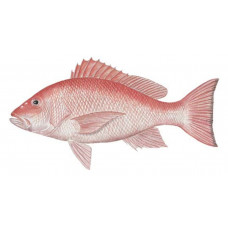Latin name
Lutjanus campechanus
Other names
American red snapper, northern red snapper, mutton snapper; Portuguese: vermelho; Spanish: guachinango del Golfo, pargo colorado, pargo de Golfo.
Identification
Body is moderately high. Eyes small. Nostrils without tubes, situated close to each other. The anal fin is pointed. Red snapper has a pinkish, scarlet or brick-red head and upper body and a silvery-white bottom. It has a long triangular snout, a pointed anal fin, and a pronounced red iris. Young fish less than 10 inches long have a dusky spot under the soft dorsal fin at or above the midline, and the tail sometimes has a dark edge. Although the adult is similar to the Caribbean red snapper, there are differences in the number of rays and scales. The Caribbean red snapper has 8 soft rays in the anal fin, 50-51 scales in a row along the flank and 10-11 scales between the beginning of the dorsal fin and the lateral line. The red snapper has 9 soft rays, 47-49 scales on the flank and 8-9 scales between the dorsal fin and the lateral line. Fish up to 30-35 cm long have a black spot on the back at the level of the dorsal fin anterior soft rays.
Distribution
Red snapper are found in the Gulf of Mexico and along the entire U.S. Atlantic coast all the way to Massachusetts, rarely north of the Caroline Islands. They are occasionally found in Florida, absent in the Bahamas and the Caribbean.
Habitat
Sea-bottom fish of shelf waters. Prefers bottom areas with corals and rocks, as well as sandy bottom with individual stones and reefs. Occurs at depths of up to 270 m, preferring depths of 20 to 160 m. Young fish occur over sandy and muddy bottom at shallower depths. It lives near the bottom at a temperature of 14-30 °C and salinity of 33-37%.
Size
Usually growing to 1-2 feet in length, red snapper can reach 3 feet and weigh over 35 pounds. The world record for all snapper is a Louisiana fish weighing 50 pounds 4 ounces. Adults can live more than 20 years.
Life history and Behavior
Red snapper spawn from June through October, and sometimes as early as April. They are often mixed with grunts and other snapper in schools. It takes these fish 3 to 4 years to reach spawning size of 15-16 inches. In the Gulf of Mexico, the fish come closer to shore in the summer to depths of 20-40 m, and migrate to depths of 50-100 m in the winter.
Food and feeding habits
Zoophagan. It is an opportunistic bottom dweller that feeds mainly on fish and crustaceans (shrimps and crabs). In addition, they eat worms, mollusks, ascidians, etc. As they grow, fish consumption increases.
Reproduction
It reaches sexual maturity at the age of 4 years in the Campeche Bank area, with an average length of 36.8 cm. In the Gulf of Mexico, spawning occurs at depths of 20-40 m from April through December (spawning peaks in June through August). Off Southwest Florida, spawning occurs in August-September. The diameter of hatched eggs is 0.7-0.9 mm.
| Classification | |
| Phylum | Chordata |
| Class | Actinopterygii |
| Squad | Perciformes |
| Family | Lutjanidae |
| Genus | Lutjanus |
| Species | L. campechanus |
| Features | |
| Conservation status | Vulnerable |
| Habitat | Pelagic |
| Life span, years | 100 |
| Maximum body weight, kg | 22.79 |
| Maximum length, cm | 100 |
| Sailing speed, m/s | No information |
| Threat to people | Edible |
| Way of eating | Predator |




